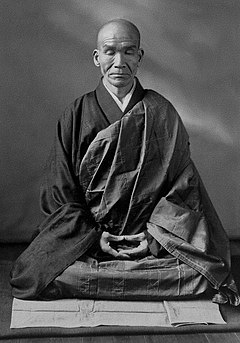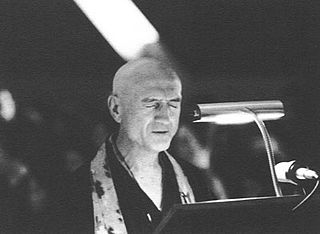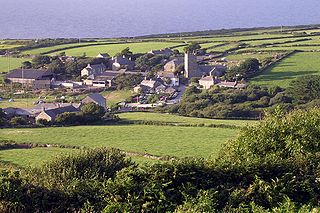
A kōan (公案) is a story, dialogue, question, or statement which is used in Zen practice to provoke the "great doubt" and to practice or test a student's progress in Zen.

A Zener diode is a type of diode that allows current to flow not only from its anode to its cathode, but also in the reverse direction, when the voltage across its terminals exceeds the Zener voltage, a characteristic of the device. This effect is known as the Zener effect, after Clarence Zener, who first described the phenomenon.

Zazen is a meditative discipline that is typically the primary practice of the Zen Buddhist tradition. The precise meaning and method of zazen varies from school to school, but in general it can be regarded as a means of insight into the nature of existence. In the Japanese Rinzai school, zazen is usually associated with the study of koans. The Sōtō School of Japan, on the other hand, only rarely incorporates koans into zazen, preferring an approach where the mind has no object at all, known as shikantaza.
Sōtō Zen or the Sōtō school is the largest of the three traditional sects of Zen in Japanese Buddhism. It is the Japanese line of the Chinese Cáodòng school, which was founded during the Tang dynasty by Dòngshān Liánjiè. It emphasizes Shikantaza, meditation with no objects, anchors, or content. The meditator strives to be aware of the stream of thoughts, allowing them to arise and pass away without interference.

Shunryu Suzuki was a Sōtō Zen monk and teacher who helped popularize Zen Buddhism in the United States, and is renowned for founding the first Buddhist monastery outside Asia. Suzuki founded San Francisco Zen Center which, along with its affiliate temples, comprises one of the most influential Zen organizations in the United States. A book of his teachings, Zen Mind, Beginner's Mind, is one of the most popular books on Zen and Buddhism in the West.

Budai is a semi-historical Chinese monk who is venerated as a deity in Chinese Buddhism and was also introduced into the Japanese Buddhist pantheon. He allegedly lived around the 10th century in the Wuyue kingdom. His name literally means "cloth sack", and refers to the bag that he is conventionally depicted as carrying as he wanders aimlessly. His jolly nature, humorous personality, and eccentric lifestyle distinguishes him from most Buddhist masters or figures. He is almost always shown smiling or laughing, hence his nickname in Chinese, the "Laughing Buddha". As he is traditionally depicted as fat, he is also referred to as the "Fat Buddha".

Alan Wilson Watts was a British philosopher who interpreted and popularised Eastern philosophy for a Western audience. Born in Chislehurst, England, he moved to the United States in 1938 and began Zen training in New York. Pursuing a career, he attended Seabury-Western Theological Seminary, where he received a master's degree in theology. Watts became an Episcopal priest in 1945, then left the ministry in 1950 and moved to California, where he joined the faculty of the American Academy of Asian Studies.
Shikantaza (只管打坐) is a Japanese translation of a Chinese term for zazen introduced by Rujing, a monk of the Caodong school of Zen Buddhism, to refer to a practice called "Silent Illumination", or "Serene Reflection", by previous Caodong masters. In Japan, it is associated with the Soto school. Unlike many other forms of meditation, shikantaza does not require focused attention on a specific object ; instead, practitioners "just sit" in a state of conscious awareness.

Daisetsu Teitaro Suzuki was a Japanese author of books and essays on Buddhism, Zen (Chan) and Shin that were instrumental in spreading interest in both Zen and Shin to the West. Suzuki was also a prolific translator of Chinese, Japanese, and Sanskrit literature. Suzuki spent several lengthy stretches teaching or lecturing at Western universities, and devoted many years to a professorship at Ōtani University, a Japanese Buddhist school.

Philip Kapleau was a teacher of Zen Buddhism in the Sanbo Kyodan tradition, a blending of Japanese Sōtō and Rinzai schools.
Rōshi (老師) is a title in Zen Buddhism with different usages depending on sect and county. In Rinzai Zen, the term is reserved only for individuals who have received inka shōmei, meaning they have completed the entire kōan curriculum; this amounts to a total of less than 100 people at any given time. In Sōtō Zen and Sanbo Kyodan it is used more loosely. This is especially the case in the United States and Europe, where almost any teacher who has received dharma transmission might be called rōshi, or even use it to refer to themselves, a practice unheard of in Japan.
The Rinzai school is one of three sects of Zen in Japanese Buddhism.

Seungsahn Haengwon, born Duk-In Lee, was a Korean Seon master of the Jogye Order and founder of the international Kwan Um School of Zen. He was the seventy-eighth Patriarch in his lineage. As one of the early Korean Zen masters to settle in the United States, he opened many temples and practice groups across the globe. He was known for his charismatic style and direct presentation of Zen, which was well tailored for the Western audience.

Taisen Deshimaru was a Japanese Sōtō Zen Buddhist teacher, who founded the Association Zen Internationale.

Zen is the Japanese variant of Chan Buddhism, a Mahayana school that strongly emphasizes dhyana, the meditative training of awareness and equanimity. This practice, according to Zen proponents, gives insight into one's true nature, or the emptiness of inherent existence, which opens the way to a liberated way of living.
Zen master is a somewhat vague English term that arose in the first half of the 20th century, sometimes used to refer to an individual who teaches Zen Buddhist meditation and practices, usually implying longtime study and subsequent authorization to teach and transmit the tradition themselves.

A Dharma talk (Sanskrit) or Dhamma talk (Pali) or Dharma sermon is a public discourse on Buddhism by a Buddhist teacher.

The Asus ZenFone is a series of Android smartphones designed, marketed and produced by Asus. The first-generation ZenFones were announced at the 2014 Consumer Electronic Show in Las Vegas, Nevada. In addition to its Intel Atom, Qualcomm Snapdragon, and MediaTek processors and the Android operating system, some ZenFone also features the Zen UI, a user interface from Asus.














